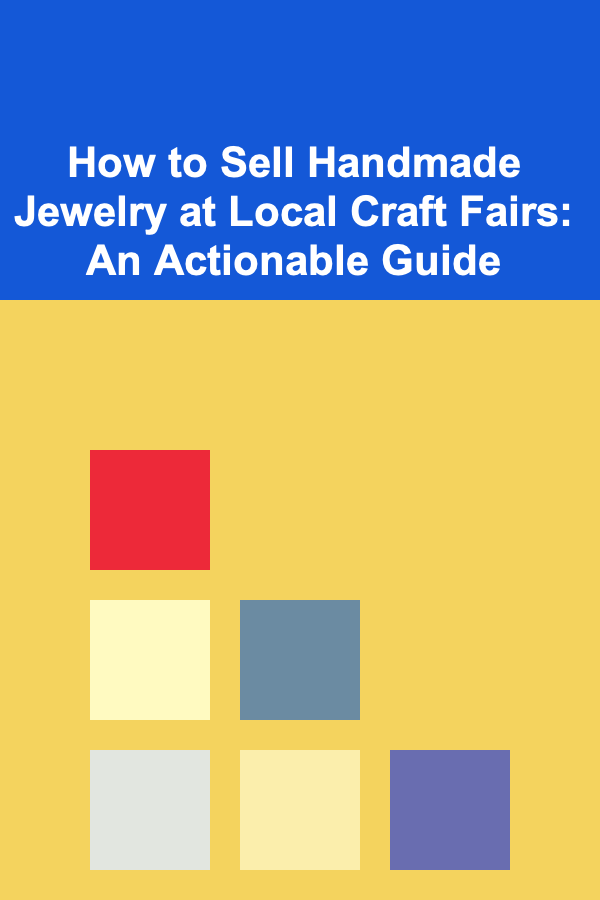
How to Sell Handmade Jewelry at Local Craft Fairs: An Actionable Guide
ebook include PDF & Audio bundle (Micro Guide)
$12.99$9.99
Limited Time Offer! Order within the next:

Selling handmade jewelry at local craft fairs can be a rewarding experience. Not only does it allow you to showcase your creative designs and earn money, but it also gives you the chance to connect with your community and build a loyal customer base. However, the key to success lies in preparation, presentation, and effective sales techniques. This guide will provide you with actionable steps to sell your handmade jewelry successfully at local craft fairs.
Understand Your Audience
The first step in preparing for any craft fair is understanding your target market. Who are the people that attend these events? What are their interests, and what type of jewelry are they likely to purchase? Here's how you can break it down:
1.1. Know the Demographics
Different craft fairs attract different types of crowds. Some may cater to a more youthful, trendy audience, while others may attract individuals who appreciate traditional or vintage designs. Do some research on the types of attendees your craft fair typically attracts. Are they more interested in costume jewelry, elegant designs, or minimalist pieces? Knowing your audience helps you tailor your designs and presentation to match their preferences.
1.2. Create Jewelry That Appeals to Your Market
Once you understand the audience, adapt your jewelry collection to meet their tastes and budget. If the event is targeted towards a younger demographic, you might want to focus on fun, bold, and trendy pieces. For an older, more established audience, consider offering classic, timeless designs. Remember to also cater to different price points, so you can appeal to both budget-conscious shoppers and those looking to make a larger purchase.
Prepare Your Inventory
Having the right variety and quantity of jewelry is crucial. You want to ensure that your booth is well-stocked and that your products stand out. Here are the essential preparation steps:
2.1. Quantity vs. Quality
Make sure you have enough pieces to display and sell throughout the event. The number of pieces you bring depends on the size of the event, but typically, you should bring anywhere from 30 to 100 pieces, depending on your designs and the length of the fair.
While quantity is important, the quality of your jewelry is what will keep customers coming back. Ensure that each piece is crafted to the highest standards and free of defects. It's also a good idea to bring a few pieces that are more intricate or unique, as they can attract attention.
2.2. Diverse Range of Products
Having a variety of styles, colors, and sizes can appeal to different tastes. Consider offering:
- Necklaces, Bracelets, and Earrings: Diversify your product offerings so that you have something for everyone.
- Customizable Options: Offering personalized pieces like name bracelets or birthstone necklaces can help set you apart from other vendors.
- Special Collections: If you make jewelry for specific occasions (e.g., wedding jewelry, holiday-themed pieces), having these available can cater to seasonal buyers.
2.3. Packaging and Display
Consider how you will package and display your jewelry. Jewelry that is neatly presented will catch the eye of potential buyers. Use:
- Jewelry Stands: Make sure to use elegant and organized stands to showcase your items. Displays should allow customers to easily view and try on the jewelry.
- Branding: Having a clear brand presence is crucial. Consider using custom packaging, branded tags, and a business card to add professionalism to your booth.
Set Up an Attractive Booth
Your booth is the first thing potential buyers will see, so it's essential to make it visually appealing and organized. Here's how you can create an attractive booth that draws in customers:
3.1. Create a Focal Point
Your booth should have a focal point that immediately attracts attention. This could be a bold, statement piece of jewelry that stands out, a large sign with your brand name, or a display that shows off your best-selling items. Use height, colors, and lighting to make the display pop.
3.2. Use Proper Lighting
Good lighting can make a huge difference in how your jewelry is perceived. Make sure your booth is well-lit, especially if you are selling in a dimly lit space. Use LED lights or small spotlights to highlight your pieces without making the display too harsh.
3.3. Keep It Organized
A cluttered booth can turn customers away. Ensure that your jewelry is neatly displayed, with each piece easy to access and view. Group similar items together (e.g., all necklaces in one area, earrings in another) and make sure your pricing is clearly visible.
3.4. Display Your Story
Share your personal story and the inspiration behind your jewelry. Having a sign or a printed piece that explains the process of how your jewelry is made or why you started your business can create a personal connection with potential buyers. People love knowing the story behind a product, especially when it's handmade.
Price Your Jewelry Strategically
Pricing can be a delicate balance. You want to make your jewelry accessible, but you also need to ensure you're getting paid fairly for the time and materials involved in making it. Here's how you can set competitive and fair prices:
4.1. Understand Your Costs
Before setting any prices, calculate the cost of materials, labor, booth fees, and any other expenses. Ensure you factor in a reasonable markup to cover your costs and make a profit. Consider using a cost-plus pricing strategy, where you add a markup to the total cost of creating a piece of jewelry.
4.2. Offer a Range of Prices
Offering jewelry at various price points can attract a wider audience. Some shoppers may be looking for affordable, everyday pieces, while others may be willing to spend more for a unique or luxury item. Make sure to have a balance between budget-friendly pieces and higher-end designs.
4.3. Offer Discounts or Bundles
Discounts or bundle deals can be an effective way to encourage people to buy more. For example, you could offer a discount on a set of matching jewelry (a necklace and earrings together) or offer a "buy one, get one half-off" promotion.
Engage with Customers
Building rapport with your customers is key to making a sale. You want them to feel comfortable, informed, and confident in their purchase. Here are some tips on how to engage with customers effectively:
5.1. Be Approachable
Smile, greet visitors warmly, and be ready to engage in conversation. People are more likely to buy from you if they feel comfortable and welcomed. Approach potential buyers, but avoid being too pushy. Sometimes, a friendly conversation is all it takes for a customer to make a purchase.
5.2. Share Your Process
Be prepared to talk about how your jewelry is made. Sharing your design process, the inspiration behind your creations, and any techniques you use to craft your pieces can make the product more valuable in the eyes of the customer.
5.3. Offer Jewelry Care Tips
Provide value by sharing tips on how to care for the jewelry. For example, explain how to keep it clean, prevent tarnishing, or store it properly. This not only positions you as an expert but also helps build trust with your customers.
5.4. Use Social Proof
If you have a strong online presence, make sure to mention it. Encourage customers to check out your social media pages for customer reviews, behind-the-scenes looks, or more photos of your jewelry. If your jewelry has been worn by influencers or featured in the media, be sure to mention it as well.
Follow Up After the Event
The relationship with your customer doesn't have to end once the craft fair is over. In fact, follow-up can be one of the most powerful tools to build repeat business.
6.1. Collect Customer Information
Ask customers if they'd like to be added to your mailing list to receive updates on new products or upcoming sales. This allows you to keep in touch and nurture a long-term relationship with them.
6.2. Send Thank You Notes
After the event, consider sending thank-you notes to customers who made purchases. A simple message of appreciation can go a long way in building goodwill and loyalty.
6.3. Continue Engagement Online
Stay active on social media and your website, especially after the fair. Share photos from the event, thank attendees for visiting, and keep posting new designs to keep your brand top-of-mind.
Learn from Each Event
Craft fairs can vary in size and demographic, and it's essential to learn from each experience. After each fair, reflect on:
- Which pieces sold well?
- Which customers seemed most interested in your jewelry?
- What strategies worked (and which didn't)?
Continuously improving your approach based on feedback and observations can help you optimize your future sales efforts.
Conclusion
Selling handmade jewelry at local craft fairs requires a combination of creativity, preparation, and customer engagement. By understanding your audience, preparing an appealing display, pricing your jewelry strategically, and building strong relationships with your customers, you can maximize your success. Craft fairs provide an excellent opportunity to showcase your work, connect with people, and grow your business.

How to Designate a Holiday Decoration Area in Your Home
Read More
How to Organize Sewing Patterns and Fabric Scraps
Read More
How to Set Up a Library that Adapts as Your Collection Grows
Read More
How to Use Rugs to Transform Your Space on a Budget
Read More
How to Get ChatGPT to Generate Personal Growth Plans
Read More
10 Tips for Planning Your Knitting Projects Around a Busy Schedule
Read MoreOther Products

How to Designate a Holiday Decoration Area in Your Home
Read More
How to Organize Sewing Patterns and Fabric Scraps
Read More
How to Set Up a Library that Adapts as Your Collection Grows
Read More
How to Use Rugs to Transform Your Space on a Budget
Read More
How to Get ChatGPT to Generate Personal Growth Plans
Read More